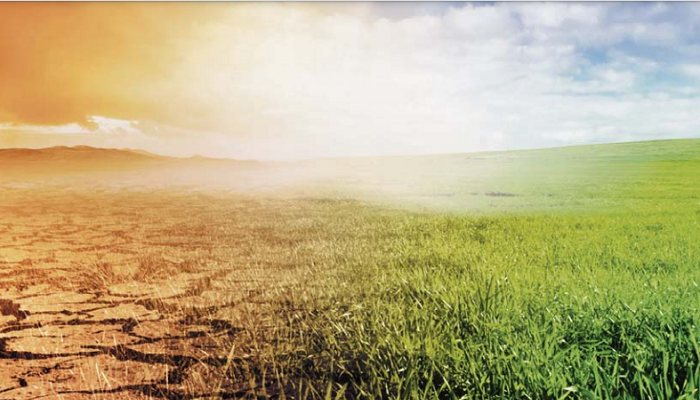How big is your carbon footprint?

Regardless of your enterprise mix, carbon footprint is becoming a key indicator of farm efficiency. In this article first published in Today's Farm Siobhán Kavanagh & Gráinne Hurley, Teagasc and Eleanor Murphy, Bord Bia explain what climate change is about and discuss the carbon footprint of farms
What is the difference between weather and climate?
The weather is the wind, rain, temperature etc, that we experience on any given day. Climate is how the weather conditions are over a much longer timeframe.
What is climate change?
Climate change is a change in climate, which is currently being driven by an increase in global temperatures resulting from increasing levels of greenhouse gases (GHG) in the atmosphere.
Why are they called greenhouse gases?
These gases trap heat in the atmosphere like the glass in a greenhouse does. The more greenhouse gases, the more heat is trapped, resulting in global warming.
What are the main greenhouse gases relevant to agriculture?
The three agricultural GHGs are carbon dioxide, (CO2 ), methane (CH4 ) and nitrous oxide (N2 O). What are the main sources of these GHGs? In most countries in Europe, the human population is greater than the cattle population, so emissions are much greater from human or industrial sources than from agriculture. In Ireland, agriculture contributes 35% of the total GHG emitted. Animals (CH4 , 64%) and fertiliser (N2 O, 32%) contribute the most to GHG emissions from agriculture.
What is a carbon footprint?
The carbon footprint refers to the ratio of how much GHGs are emitted from an activity, such as the production of milk or meat, or driving a car or taking a flight. The emissions of all GHG gases are expressed as carbon dioxide equivalents (CO2 Eq) for ease of comparison. In farming, the production of every kilogramme of milk, meat or grain has a carbon footprint. The carbon footprint is the ratio of total GHG emissions to total outputs of the farm enterprise. Output for dairy is kilograms of fat and protein corrected milk (FPCM) and kilograms liveweight for beef. As farmers, you are being asked to reduce GHG emissions from your farming system to help alleviate global warming. But how can you be expected to do this if you don’t know what your current emissions are? You do have access to your carbon footprint figure, however. Over 54,000 farmers nationally, dairy and beef, have a carbon emissions figure available to them, but many are not aware of this information. After each Bord Bia audit, all certified dairy and beef farmers receive a Farmer Feedback Report with their farm’s carbon footprint, as well as an assessment of farm productivity, nutrient management, grassland, animal feeding and farm safety.
How is the carbon footprint calculated?
Bord Bia utilises a beef and dairy carbon footprint model to calculate the carbon footprint of a herd. Both of these models have been developed with Teagasc and are accredited by the Carbon Trust to its PAS 2050 Standard. There are four sources of data required to complete an accurate calculation of a farm’s carbon footprint. Bord Bia has data sharing and transfer arrangements in place with industry stakeholders to reduce the burden of data collection on the farmer.
•Animal Identification and Movements Database (AIM) – DAFM – Beef and dairy.
•Daily Liveweight Gain – Irish Cattle Breeding Federation (ICBF) – Beef only.
•Milk Production Data – Dairy processors - Dairy only.
•Sustainability Survey – Scheme Members – Beef and dairy. The sustainability survey is the only data source required for the carbon footprint calculation that is collected directly from the farmer.
How does the information provided in the sustainability survey relate to the carbon footprint?
The sustainability survey captures data related to farm inputs and farm management. The main farm activity data collected via the survey is outlined below;
- Turnout and housing: Required to calculate the grazing and housing periods of animals on the farm. This data influences the calculation of manure storage emissions, grazing and digestion-related emissions and can influence the grass-fed status of a herd.
- Manure management: Calculates the emissions from the application and storage of manure on the farm. This is influenced by the timing of manure application and the method by which manure is applied to the land.
- Concentrate feeding rates: Calculates the emissions associated with the production of concentrate feed which is fed to animals. This data can also influence the grass-fed status of the herd. Milk replacer feeding rates are also captured in this section under calf management.
- Fertiliser application data is required to track the emissions from the production of fertilisers and minerals and the emissions related to the application of fertiliser to the land.
- It is important to note that inaccurate data provided to the sustainability survey can result in an inaccurate carbon footprint, grass-fed result, and Farmer Feedback Report.
When do you get the Farmer Feedback report?
The feedback report is posted to the farmer within one week of certifi cation of the Bord Bia audit. It can also be accessed from the audit portal website, farm.bordbia.ie using your username and PIN, which you received after the most recent audit.
Where do you find the carbon footprint on the report?
Your most recent carbon footprint is displayed on the first page of the report, alongside percentage change from the previous audit (where available) and the typical carbon footprint of farms within your category. It appears again in section two, page three. Current assessment refers to the footprint of the farm at the time of the most recent audit, the percentage change refers to the increase or decrease since the previous audit and the average for the 125-150 cow farms refers to other farms with similar cow numbers. For beef systems, this could be comparing a suckler-to-beef enterprise to other suckler-to-beef operations.
Target Carbon Footprint
The milk production target for carbon footprint is 0.70kg CO2 eq per kg FPCM. The target carbon footprint for suckler beef systems is 13.2kg CO2 eq per kg liveweight, assuming a kill out of 56%. Dairy beef targets are being developed. However, reducing carbon footprint without a corresponding reduction in total gas emissions from an individual farm will not reduce our overall emissions.
How do you know what is contributing to your carbon footprint?
On page three, a graph displays the percentage share of carbon emissions on your farm under the following headings – animal digestion, manure, fertiliser, forage/feed production, other (transport, fuel, etc).
In the information and advice section, there are green and white-shaded leaves – what do these colours indicate?
The advice is broken down into two levels of activity. The green leaf relates to actions specifi cally set out in the Teagasc Marginal Abatement Cost Curve (MACC). These actions are provided to encourage farmers to engage with the Climate Action Plan and inform farmers on those types of actions. For example, on the farm emissions section, the advice is to improve EBI, consider the use of sexed semen and improve animal health to reduce emissions. While in the fertiliser advice section, the advice is to soil test, apply lime and use protected urea. The white leaf relates to more general information.
What should a farmer do after receiving the report?
Some farmers may feel satisfi ed to interpret the report themselves. Others may wish to share the report with their advisor and discuss the next steps for improvement with them. The advisor will be able to see quite clearly where the different emissions are coming from and help the farmer identify which areas to focus on.
Dairy farmer

John and Brendan Walsh, Signpost Dairy farmers
We will examine the farmer feedback report for John and Brendan Walsh, Signpost Dairy farmers, farming in Ballylooby, Cahir, Co Tipperary. The father and son team are milking 132 cows, achieving milk solids per cow of 539kg. “We had our last audit in September 2020,” says John. “We take care in completing the Sustainability Report because we need to ensure that we have an accurate fi gure for the carbon footprint to benchmark progress year-on-year and against other farmers.” In John’s case, the carbon footprint was 1.10kg CO2 Eq/kg fat and protein corrected milk, which was 3% lower than it was in 2019 and 4.5% lower than farms of similar scale. Thirty nine percent of the emissions on the farm are from animal digestion, compared to 39% from the previous audit and 42% for the average farms of similar scale. Fertiliser use contributes to 18% of emissions, compared to 16% for the average farms of similar scale John has met with his advisor Kevin Barron and programme advisor Grainne Hurley and decided on a plan of action to reduce emissions further on the farm. Some of the actions that are currently being taken include:
- White clover has been incorporated into the swards on the milking block. They have currently five paddocks that have received no chemical nitrogen since May.
- All slurry is spread using Low Emission Slurry Spreading (LESS). The farm has invested in a dribble bar.
- Protected urea fertiliser is being used on the farm.
- Red clover has been sown on the outside blocks for silage.



Beef farmer
Beef farmer Jarlath Ruane runs a dairy calf-to-beef enterprise near Claremorris, Co Mayo. Jarlath’s footprint was 8.11kg CO2 per kilogram beef liveweight in 2020. This had not changed since 2018, but is almost 12% lower than the average for dairy calf-to-beef farms. As with John and Brendan Walsh, Jarlath takes great care in completing the sustainability survey to ensure that he gets an accurate carbon footprint. Forty eight percent of Jarlath’s emissions come from animal digestion (or methane) with 27% coming from manure, 7% from fertiliser, 3% from forage and feed and 15% coming from other activities including transport.
The key actions that Jarlath is taking to reduce his carbon footprint include:
- Incorporating clover into new reseeds to reduce chemical N usage.
- Increasing usage of protected. urea on-farm, replacing CAN-based products.
- Concentrating on calf health and grassland management to increase carcase weight of each animal.
- Putting plans in place to convert to low emission slurry spreading.
- Maximising silage quality in order to reduce meal requirements of young cattle, stores and fi nishing cattle. James Fitzgerald is his Green Acres programme advisor and Amy Connolly is his local Teagasc advisor.
As farmers are beginning on the journey towards reducing gaseous emissions, it is important that you know where you are starting from. It’s the old adage – you can’t change what you don’t measure. Take the time today to root out your most recent Farmer Feedback Report and make a start.
Read this article in Today's Farm at Signpost Programme - How big your carbon footprint (PDF)
Read more articles in Today's Farm - September/October 2021 here
Find out all about the Signpost Programme here
Signpost Newsletter Subscription
Subscribe to our newsletter and stay updated on what The Signpost Programme is doing to lead climate action by Irish farmers and their transition towards more sustainable farming systems


